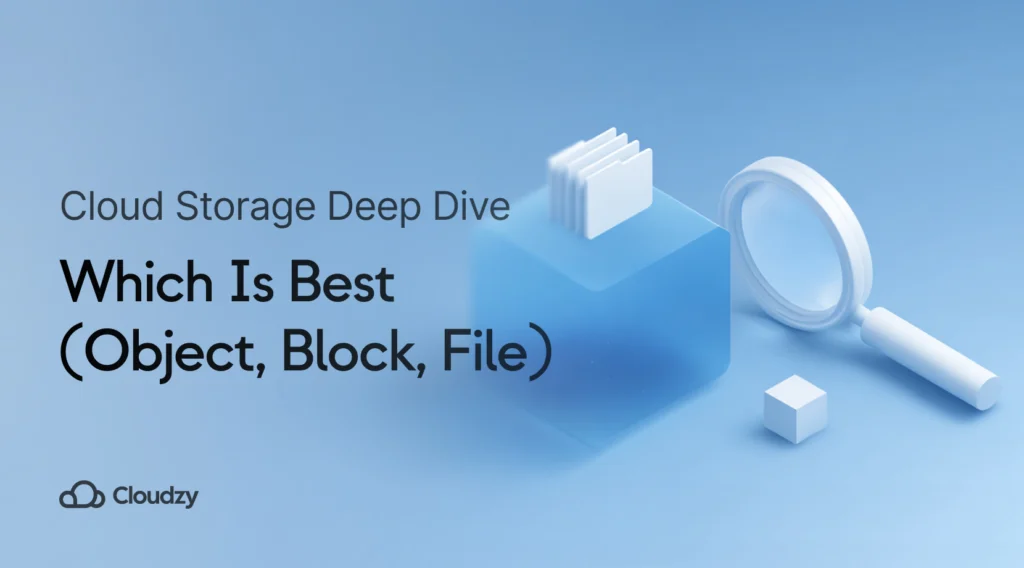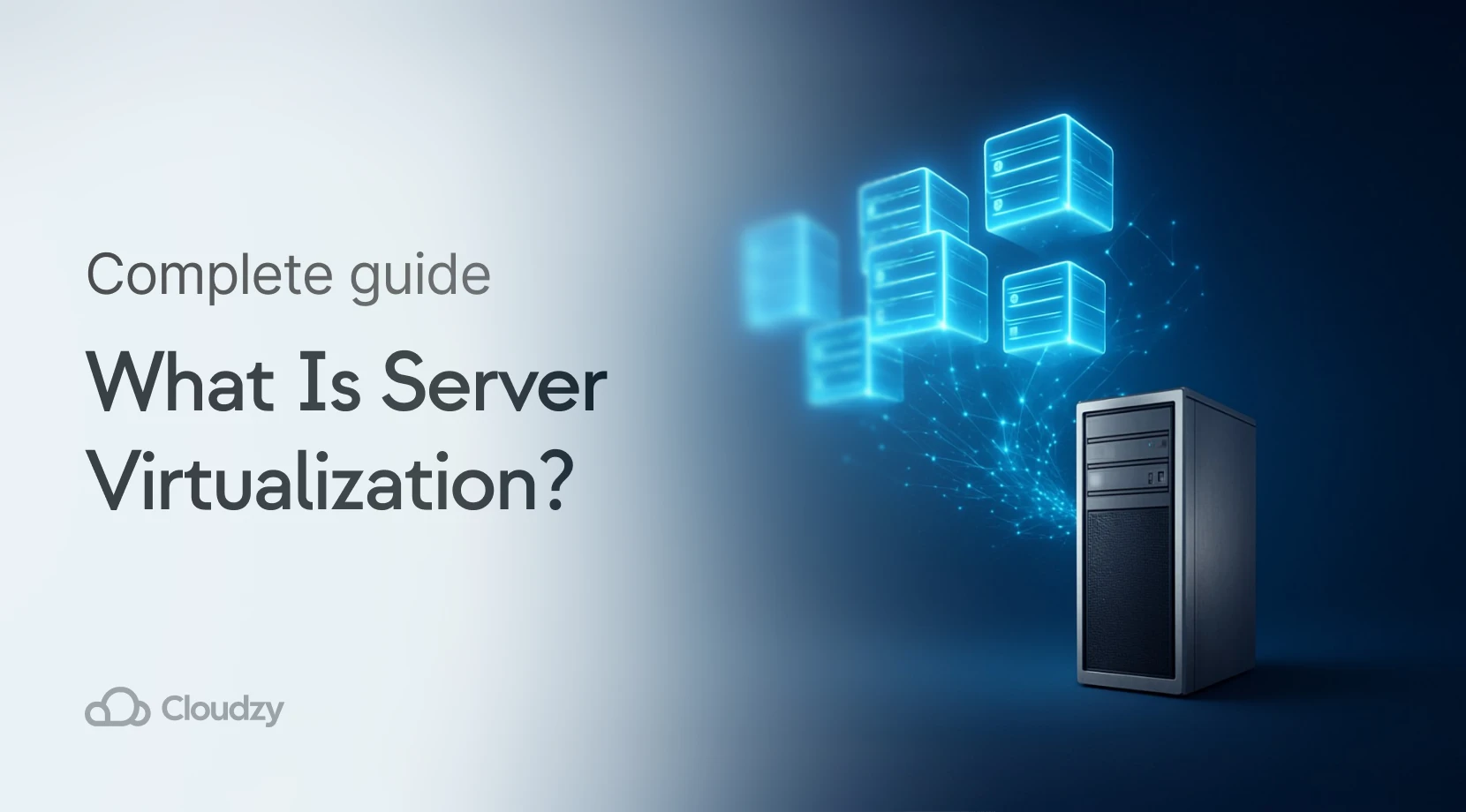Storage labels pile up fast: S3, NFS, iSCSI, CIFS—you name it. If you run a growing SaaS or analytics stack on a VPS, picking between Object vs. Block vs file storage can feel like a pop quiz you never studied for. Oftentimes, teams inevitably have to go through the same decision-making process, and the pattern is clear: match IOPS, throughput, and data persistence needs to the right layer, and costs shrink while performance climbs.
In the next ten minutes, you’ll see all cloud storage types explained without hand‑wavy marketing. I will pinpoint when to use object storage, why Block still rules databases, and where VPS file storage options fit when shared folders matter. I’ll even flag a few traps—provisioning latency, hidden egress charges, and the dreaded scalability ceiling—so you can sidestep them.
By the end, the object vs. Block vs file storage question will feel less like a riddle and more like a menu.
- What Are Cloud Storage Fundamentals?
- Breaking Down Block Storage: Use Cases & Limitations
- Understanding Object Storage: Scalability & Benefits
- File Storage Explained: Familiarity & Use Cases
- Key Differences: A Comparison Table
- How VPS Storage Options Fit In
- Choosing the Right Storage for Your Project
- Final Thoughts
- FAQ
What Are Cloud Storage Fundamentals?
Before naming winners, let’s ground ourselves in the metrics that actually steer performance and cost.
- Latency: The time between a read or write request and the first byte returned.
- IOPS (input/output operations per second): Indicates how many small, random operations a drive can handle.
- Throughput: The sustained volume of data transferred per second—important for backups and media.
- Storage scalability: How easily you can expand capacity without forklift upgrades.
- Data persistence & durability: The odds of losing a bit over a given period; leading object services target eleven nines.
- Protocol comfort: S3 compatible APIs, NFS mounts, or SMB/CIFS share shape developer effort.
Understanding these building blocks turns a wall of jargon into practical levers. Keep them close; we’ll refer back as each model enters the ring.
Why Fundamentals Matter
Think about a real‑world SaaS dashboard that keeps a 2 GB JSON blob in RAM‑backed cache; the moment a user toggles a filter, the app only needs a couple of 4 kB blocks off an NVMe volume. Here, shaving two milliseconds off latency delivers noticeably snappier charts, so IOPS and drive class rise to the top of the priority list.
Now flip to a retail chain that stores 500 TB of night‑vision CCTV and must retain footage for seven years. Nobody minds waiting a minute to pull last winter’s video of aisle five, but finance watches every cent. Tiering that data to an S3‑compatible archive bucket at four dollars per terabyte—and then lifecycle‑moving year‑old footage to deep‑cold at roughly a dollar and change—keeps compliance officers and accountants satisfied. Different benchmarks, different winners.
Solid storage design still rests on airtight defenses; tighten IAM guardrails and encryption keys first, then size your volumes. For a quick refresher on sealing those gaps, skim our cloud security guide, which breaks down shared responsibility gotcha and rapid-response practices.
Breaking Down Block Storage: Use Cases & Limitations
Block storage carves virtual disks into fixed‑size blocks that mimic local drives. Your operating system formats them, and then databases or VM images treat them like any other disk.
Great fits
- High‑transaction OLTP databases that need predictable IOPS.
- Low‑latency boot volumes for compute instances.
- Log aggregation buffers that rotate quickly but must survive instance restarts.
Hard limits
- Scaling means bigger or more volumes, not infinite buckets.
- Native snapshots live in the same zone, so off‑site protection requires manual replication.
- Metadata lives outside the volume, reducing searchability compared with object peers.
When you stack the numbers, Block still crushes write latency, yet it often costs more per gigabyte. Keep that in mind whenever the Object vs. Block vs. file storage conversation drifts toward the budget.
Understanding Object Storage: Scalability & Benefits
Object stores wrap data and rich metadata inside a flat namespace, reached through REST calls or S3-compatible SDKs.
Why it shines
- Near‑infinite buckets: Storage scalability arrives without re‑partitioning.
- Custom metadata: Tag files with project IDs or retention flags for painless governance.
- Built‑in versioning and lifecycle rules: Perfect for data archiving and legal holds.
You might wonder when to use object storage instead of the trusty block volume. My shortcut: anything over 100 GB that users rarely modify, yet might read from multiple regions, belongs here. Big‑data lakes, static web assets, and machine‑learning training sets check that box. Repeat the mantra—when to use object storage, when to use object storage, when to use object storage—and you’ll quickly identify edge cases that still prefer blocks.
File Storage Explained: Familiarity & Use Cases
File storage exposes a hierarchical tree that feels like a shared drive. Mount it with NFS or CIFS, set permissions, and your DevOps playbooks stay the same.
Why teams still love it
- Lift‑and‑shift legacy apps that expect /mnt/projects.
- Media production pipelines where editors collaborate on the same file.
- Simple quota management by directory.
Modern VPS file storage options mirror that familiarity while adding pay‑as‑you‑grow capacity. Still, remember that every extra metadata call adds latency compared with raw block IO. Measure twice, map once, and keep VPS file storage options on a dedicated, low‑jitter network segment for best results.
Key Differences: A Comparison Table
Sometimes, words blur together. The table below lines up the key points so your eyes can pick a winner in seconds.
| Feature | Block Storage | Object Storage | File Storage |
| Access Protocol | iSCSI, NVMe‑oF | REST, S3 compatible | NFS, SMB/CIFS |
| Typical Latency | < 5 ms | 30–100 ms | 5–15 ms |
| Max Capacity | Volume size limits (varies by host) | Virtually unlimited | Scales to cluster limits |
| IOPS Focus | High, consistent | Moderate | Moderate |
| Throughput | High with striping | High for sequential reads | Medium |
| Metadata | Minimal, external | Rich, extensible | Standard POSIX |
| Ideal Workloads | Databases, VM disks | Backups, data archiving, media CDN | Shared home directories, CMS |
| Pricing Model | Size + IOPS tier | Size + egress | Size + throughput tier |
Look at how the Object vs. Block vs file storage trio splits responsibility. Blocks own latency, objects win storage scalability, and files deliver collaboration comfort.
How VPS Storage Options Fit In
Running your stack on a virtual private server? Good news: most providers now bundle all three services, so you rarely need to migrate clouds to get the mix you want. My rule of thumb:
- Attach a high‑performance block volume to each database node.
- Hang an NFS share for team assets and CI pipelines.
- Point backups and log exports at an S3 bucket living in the same data center.
Adopting this trio inside a single tenant cuts latency between tiers and dodges egress fees to public clouds. If you’re hunting deals, compare offerings under the umbrella of Google Cloud alternatives. Better still, spin up a test instance today—check out our cloud computing solutions, launch a pocket‑sized VPS, and benchmark real workloads in under five minutes. Pair it with our piece on understanding cloud networking components to wire packets efficiently, and you’ll have VPS file storage options humming without a surprise line item.
Choosing the Right Storage for Your Project
Decision paralysis vanishes once you map workload traits to storage traits. Use the checklist below next time a teammate asks which bucket or volume to provision.
Quick‑fire checklist
- Is the data transactional? Go Block; don’t compromise on IOPS.
- Is the dataset mostly write‑once, read‑many? That’s when to use object storage.
- Do multiple servers need the same files? File shares beat manual rsync.
- Will the footprint grow past a terabyte within a year? Plan early for storage scalability rather than last‑minute moves.
- Are audit trails or data archiving regulations in play? Object versioning and lifecycle policies simplify compliance.
- Does the app run on a VPS with steady traffic patterns? Lean on local volumes plus VPS file storage options for predictable bills.
Combine the answers, and the Object vs. Block vs. file storage puzzle solves itself. Keep our fundamentals table bookmarked, revisit it alongside cloud storage types explained sessions with your team, and you’ll outpace vendors pushing one‑size‑fits‑all pitches.
Final Thoughts
Choosing among Object vs Block vs File Storage is less about fashion and more about fitting the right bolt to the right nut. Match latency, throughput, and data persistence targets each layer, and the rest clicks into place. Your future self—with faster queries, leaner invoices, and simpler audits—will thank you.
Need a refresher on the backbone beneath every storage protocol? Our primer on cloud computing lays out IaaS, PaaS, and SaaS layers so you can spot where block, object, and file land.




One thought on “Cloud Storage Deep Dive: Which Is Best—Object, Block, or File?”
Really appreciated the way you broke down the practical differences between block, object, and file storage—it made a complex topic much more approachable. One thing that stood out was the mention of hidden egress charges; it’s something many teams overlook until it’s too late. A quick addition: it might also be helpful to touch on how hybrid storage setups can address edge cases where no single type fits perfectly.